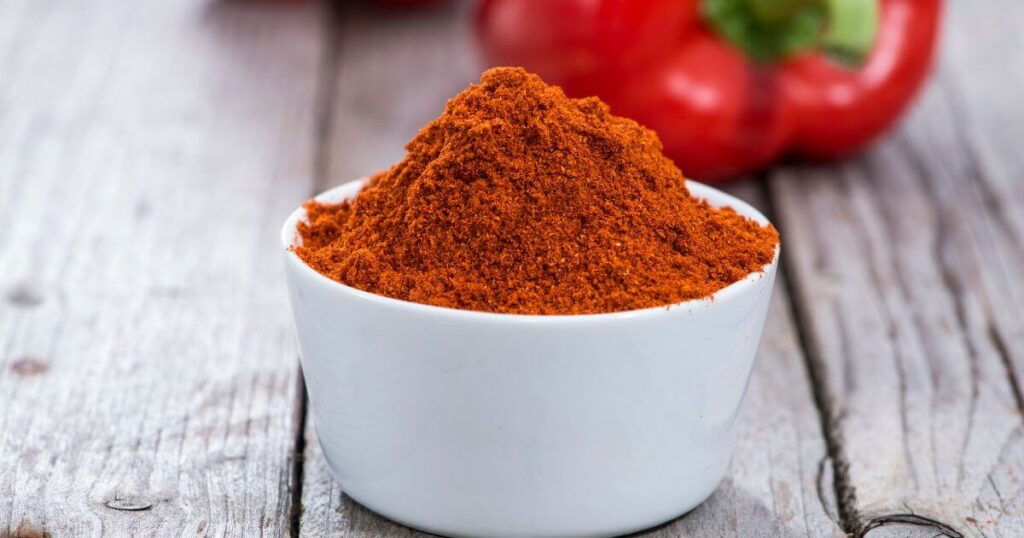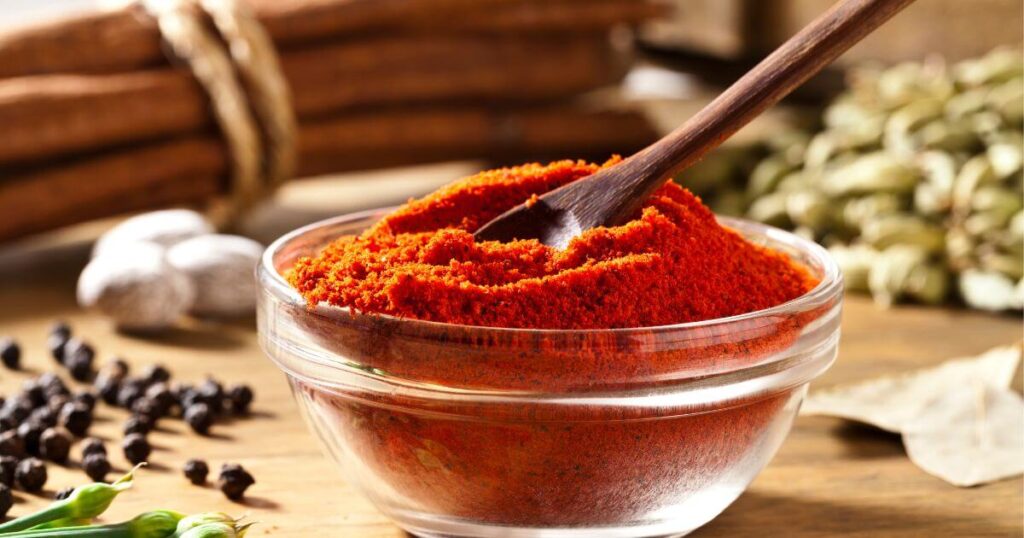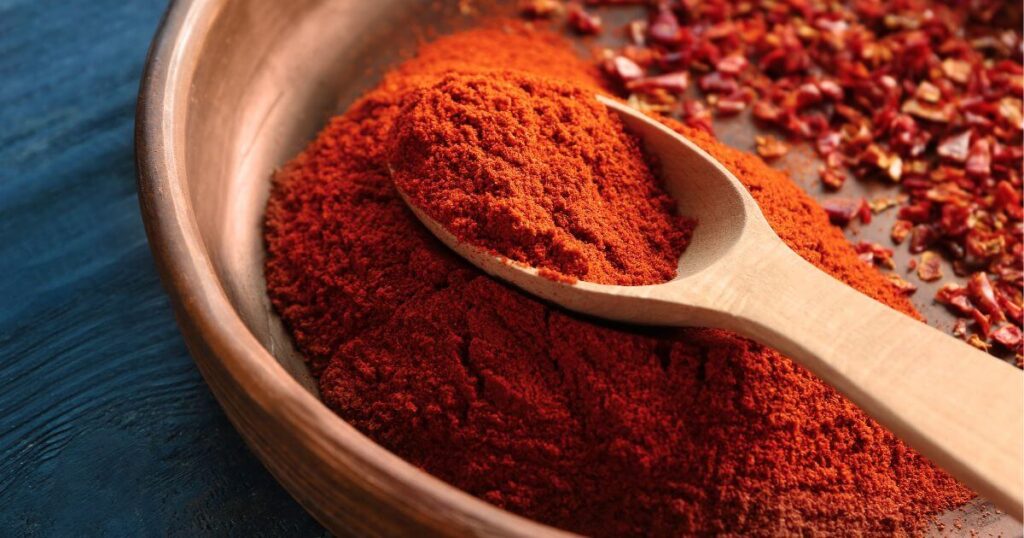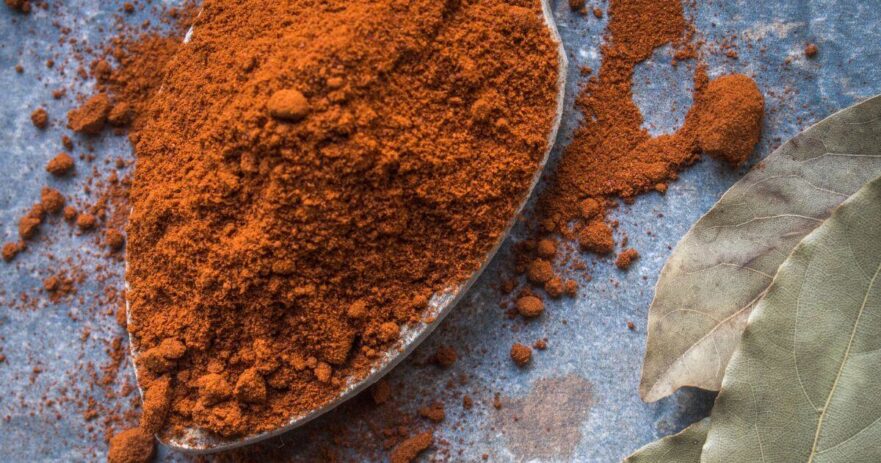In this article about spanish paprika:
🗺️ Origin and history | 🌶️ Uses | ✨ Appearance and taste | 🌶️ Types | 👨🍳 Cooking – recipes | 🛒 Where to buy | 🫙 How to store | 👨⚕️ Health benefits | 🌶️ Alternatives and substitutes | ❓ Frequently asked questions
What is Spanish Paprika?
Spanish Paprika, or Pimentón, is a signature condiment in Spanish gastronomy. It is derived from meticulously dried and ground red peppers of the Capsicum annuum variety. This vibrant spice showcases a balance of smoky and spicy undertones, earning its place in kitchens worldwide. Spanish Paprika has various flavors, from deep, earthy tones to distinctly smoky hints. This mix has carved its niche in the culinary world, serving as a star ingredient in myriad recipes. The growing admiration for its diverse taste profile makes Spanish Paprika a favorite among chefs and food enthusiasts, who relish the opportunity to infuse their culinary creations with its distinctive taste and color.
Is Spanish Paprika spicy? How hot is it?
Spanish Paprika, also known as Pimentón, boasts a range of flavors and heat owing to its multiple varieties. The three most common types are Pimentón Dulce, Pimentón Picante, and Pimentón Agridulce.
Pimentón Dulce, or sweet Spanish Paprika, comes from milder peppers and imparts a subtle warmth, making it suitable for those seeking rich flavor without a pronounced kick. It typically hovers between 100 and 500 Scoville heat units (SHUs).
Pimentón Picante, the hot version of Spanish Paprika, is made from fiery red peppers grown in Southwest Spain. It introduces a much higher heat, with Scoville ratings up to 2,500 – 4,500 SHUs. This variety offers a smoky, tangy, and spicy kick for those who appreciate a touch of fire in their dishes.
Pimentón Agridulce, the bittersweet Spanish Paprika, offers a middle ground. Its flavor profile is complex, combining the mild heat of Pimentón Dulce and the spiciness of Pimentón Picante. This type’s heat fluctuates within a moderate range, offering a balance of taste and warmth.
Spanish Paprika’s versatile varieties cater to diverse preferences, from those who enjoy gentle spice to those who prefer intense heat.
🗺️ ORIGIN AND HISTORY
Where does Spanish Paprika come from?
Spanish Paprika, known as Pimentón, owes its existence to the fertile soils of Central and South America. This is where the peppers integral to Paprika initially prospered. The transatlantic voyages of Christopher Columbus brought these peppers to Europe, setting the stage for the creation of Spanish Paprika.
The peppers found their way into Spain and flourished within the protective walls of the San Jerónimo de Yuste monastery in Extremadura, a western Spanish region boasting idyllic conditions for pepper cultivation. The monks harnessed the peppers’ potential, initially employing Paprika as a meat preservative and later recognizing its value as a potent seasoning.
Concurrently, traders transported the peppers from Spain into the Ottoman Empire and Hungary. This northern journey solidified Paprika as a cornerstone of the Hungarian culinary tradition. However, the peppers in Spain remained primarily within Extremadura’s bounds, thanks to that region’s optimal growing conditions.
Spain cultivated and refined these peppers, resulting in the diverse Spanish Paprika we encounter today. This essential spice has become emblematic of Spanish gastronomy, marrying the country’s agricultural prowess with its enthusiasm for dynamic, vibrant flavors. Pimentón illustrates Spanish cuisine’s intricate blend of exploration, adaptation, and tradition.
🌶️ USES

What is Spanish Paprika good for? How do I use it?
Spanish Paprika is a jewel in the Spanish culinary crown, demonstrating numerous applications while maintaining its unique flavor profile. The enticing red powder enriches dishes, functioning as both a dynamic component and a visually appealing garnish.
In Spain, Spanish paprika powder is pivotal in cherished local dishes. This powdered form imparts a distinct smoky-sweet depth to recipes such as Paella and Chorizo, transforming these dishes from commonplace to extraordinary. It’s a key flavor contributor, orchestrating a symphony of taste and aroma distinguishing Spanish gastronomy.
Spanish chorizo with Paprika is an iconic delicacy that showcases the depth of Spanish Paprika’s potential. The robust spice permeates the chorizo in this preparation, resulting in a smoky, flavorful experience. The spice’s vivid color also gives the chorizo an enticing, rustic appearance, stimulating the visual senses before tasting.
The iconic Octopus with Paprika, Pulpo a la Gallega, celebrates the spice’s profound, smoky undertones. The earthy Paprika amplifies the tender octopus’s subtle taste, producing a rustic and refined flavor pairing.
In another Spanish classic, Shrimp with Paprika, the vibrant spice enhances the prawns’ fresh, oceanic flavor. The dance of Spanish Paprika with these succulent shellfish creates an exotic tapestry of flavors – a hint of sweetness, a touch of smoke, and the right amount of warmth. This dish is an ode to the spice’s versatility, demonstrating how it can transform a simple seafood dish into an explosion of taste.
This smoky, sweet spice weaves a complex and delicious flavor tapestry, demonstrating its transformative power in turning the simplest dish into a masterpiece.
✨ APPEARANCE AND TASTE
What does Spanish Paprika look like?
Spanish Paprika, or Pimentón, has a captivating array of hues in its ground form, transitioning from lively orange-red to profound, smoky red. The color palette speaks volumes about the pepper varieties used. The brighter hues indicate a milder, sweeter variant, while the deeper reds represent a more robust, spicy variant. This color gradient results from their high carotenoid content, organic pigments naturally occurring in numerous fruits and vegetables. Spanish Paprika doesn’t only captivate with its powdered appearance; it also bestows any dish with an eye-catching color splash, stimulating visual and gustatory senses.
What does Spanish Paprika taste like?
Spanish Paprika delivers a spectacular range of flavors that caters to many preferences. From the delightful soft sweetness of Dulce to the pleasingly sharp bite of Picante, each variant has a unique flavor. The Dulce variety provides a subtle, fruity undertone, ideal for those who prefer mellower flavors. Picante, conversely, makes an audacious entrance with a potent, fiery kick, balancing spiciness and flavor. Amidst these variations, you’ll find Agridulce with a tantalizing bittersweet profile, a harmonious blend of mild heat, and slight sweetness. Both the non-smoked and smoked versions offer different depths and complexity to dishes, with the latter acquiring a profound smokiness from traditional oak-smoking processes. Spanish Paprika’s versatile taste contributes to its culinary value, from starring in hearty Paellas to providing subtlety in tapas.
🌶️ TYPES
What are the different types of Spanish Paprika?
The Spanish Paprika assortment, Pimentón, is a medley of flavors. Each variety is marked by its distinct color, spiciness, and taste, adding depth to Spain’s rich culinary landscape.
Spanish Paprika Flavor Varieties
- ‘Dulce’: The Spanish word for ‘sweet,’ this variant is characterized by its mild flavor and vibrant red hue. It imparts a gentle warmth and rich color without fiery heat.
- ‘Agridulce’: As the name suggests – ‘bittersweet,’ this type combines sweet and spicy notes. It offers a more complex flavor with a balanced mix of sweetness and piquancy.
- ‘Picante’: The term ‘picante’ signifies ‘hot’ in Spanish; living up to its name, this variety delivers intense heat and robust flavor, perfect for those seeking a kick in their dishes.
Smoked Pimentón Varieties
- ‘Smoked Dulce’: This is a smoked version of the sweet ‚Dulce‘ variety, where peppers are dried over an oak fire. This process imparts a distinct smoky aroma and flavor to the Paprika, enhancing its sweetness with a deep, smoky undertone.
- ‘Smoked Agridulce’: A smoked version of ‘Agridulce,’ this variant brings an intriguing combination of sweetness, spice, and smokiness, creating a multi-layered experience.
- ‘Smoked Picante’: This is the smoked variant of the hot Pimentón; a rich, smoky character complements the peppers’ heat. This variant adds complexity to a wide array of Spanish dishes.
This flavorful saga unfolds mainly in two regions of Spain, both dedicated to Paprika production and regulated under the Denomination of Origin (D.O.) boards.
One is La Vera in Extremadura, a region steeped in history, where the Jerónimos monks first practiced the iconic Spanish Paprika-making technique. La Vera’s unique terrain and climate contribute to the high carotene content of peppers, painting them an iconic bold red color. The peppers are hand-picked and slow-smoked in wood and brick smokehouses, creating the signature smoky flavor intrinsic to Spanish Paprika.
The second major Paprika-producing region is Murcia, where Paprika-making art arrived centuries ago. Here, the sweet Bola variety of pepper is sun-dried or air-dried, creating a distinct version of the spice that stands apart from the smoked La Vera variants. Paprika from Murcia celebrates sweetness, making it a unique addition to the Pimentón assortment.
👨🍳 COOKING – RECIPES

Cooking / Recipe ideas for Spanish Paprika
With its spectrum of flavors, Spanish Paprika can dramatically elevate an array of dishes. This spice shines in Spanish cuisine, acting as a color-enhancing garnish and a robust recipe base.
Consider Spanish chicken with Paprika, a delightful dish showcasing this vibrant spice’s transformative power. Spanish Paprika imbues the chicken with a depth of flavor and warmth, harmonizing with other ingredients to create a dish as hearty as it is aromatic.
Then there’s the Spanish octopus with Paprika, a maritime treasure that displays the spice’s adaptability. Spanish Paprika adds a smoky undertone to the dish, whether used in the marinade or sprinkled over the cooked octopus. This flavor note resonates with the tender, slightly sweet octopus meat.
Spanish shrimp with Paprika and pork casserole with Paprika are other examples of the spice’s prowess. Spanish Paprika is an indispensable component of these dishes, whether infusing delicate shrimp with a hint of warmth or deepening the pork casserole’s rich flavors.
Smoked Paprika with salmon and smoked Paprika with steak offer a chance to experiment with this smoky spice. The Spanish Paprika’s earthy, slightly sweet smokiness creates an unforgettable flavor when paired with the rich, fatty salmon or perfectly seared steak.
Spanish potatoes with Paprika offer a more vegetarian-friendly application of the spice. When dusted with Spanish Paprika, the potatoes transform into a delectable side dish, their earthy taste offset by the spice’s complexity.
Lastly, Spanish Paprika chicken tapas and Spanish chicken Paprika stew demonstrate the spice’s ability to influence smaller, tapas-style dishes and hearty, main-course stews. In both instances, the Spanish Paprika lays a foundation of flavor that elevates these dishes from ordinary to extraordinary.
Spanish Paprika is a culinary chameleon in subtle, delicate dishes or robust, hearty meals. It’s a spice that invites exploration and experimentation, opening the door to a world of flavors that can transform your culinary creations.
🛒 WHERE TO BUY
Where can I buy Spanish Paprika?
Finding Spanish Paprika is more straightforward than you might think. With its array of flavor profiles, this versatile spice is available in most grocery stores, nestled amongst other cooking essentials. Explore gourmet food markets for a more comprehensive selection that spans the breadth of Spanish Paprika varieties.
These specialty stores carry diverse global spices, including sweet, hot, and smoked Spanish Paprika.
In the realm of online shopping, there are vast possibilities. E-commerce platforms stock everything from commonly used to more elusive variants of Spanish Paprika. These digital marketplaces offer the advantage of home delivery, making your pursuit of this vibrant spice as simple as a few clicks. Whether you’re seeking the mildly sweet ‘Dulce,’ the bittersweet ‘Agridulce,’ or even the spicy ‘Pimentón,’ online shopping has made acquiring these unique flavors easy.
🫙 HOW TO STORE
How do I store Spanish Paprika?
Proper storage of Spanish Paprika is crucial to preserve its color and nuanced flavor. This spice thrives when stored in a cool spot, away from direct sunlight, such as in a cupboard or on a spice rack from the stove or any heat source. This safeguards the Paprika’s quality, ensuring it maintains its distinctive character.
While Spanish Paprika doesn’t necessarily spoil, its intensity can wane. Its characteristic smoky sweetness can fade, meaning you should use it within six months of purchase. Regularly replenishing your Spanish Paprika ensures you always have a vibrant, fresh stash ready to enhance your culinary creations with its signature taste and color.
❤️🩹 HEALTH BENEFITS

Is Spanish Paprika healthy?
Spanish Paprika isn’t just a culinary delight; it imparts many health benefits. This striking spice is brimming with essential vitamins, particularly vitamin A, which is crucial in supporting eye health and strengthening the immune system. It is also an impressive source of antioxidants that help prevent damage from free radicals.
Furthermore, Spanish Paprika contains capsaicin, the compound responsible for its spiciness. Capsaicin has been linked to various health advantages, such as better digestion and anti-inflammatory properties. Given its wealth of vitamins, antioxidants, and capsaicin, Spanish Paprika presents a flavourful and healthy addition to your dishes, perfectly embodying harmony between taste and health.
🔄 ALTERNATIVES AND SUBSTITUTES
What’s a good Spanish Paprika alternative?
Cooking often requires improvisation, especially when you miss a key spice like Spanish Paprika. Fortunately, several substitutes deliver similar flavors, heat, or smokiness, depending on the type of Spanish Paprika you need to replicate.
For a substitute that brings smokiness, Chipotle powder offers a compelling alternative to smoked Spanish Paprika. However, remember that Chipotle is generally hotter, so adjust the quantity accordingly.
If you’re trying to match the heat of hot Spanish Paprika, cayenne pepper can be your ally. It packs a spicier punch than most Spanish Paprika varieties, so use less.
To echo Spanish sweet Paprika or Pimentón Dulce, consider using sweet bell pepper powder, which delivers similar sweetness with vibrant color.
Crushed red pepper flakes can be a versatile substitute, providing a comparable heat and color. Remember that the texture is coarser and can impact the dish’s appearance.
In culinary improvisation, the best replacement hinges on the specific recipe and your preferences. Be bold and inventive; necessity often spurs the most delicious innovations.
How do you pronounce Spanish Paprika?
Spanish Paprika is pronounced as SPAN-ish puh-PREE-kuh.
🙋 FREQUENTLY ASKED QUESTIONS
FAQ about Spanish Paprika
Are Spanish Paprika and smoked Paprika the same?
Spanish Paprika, or 'Pimentón,' and smoked Paprika originate from Spain but are not necessarily the same. Spanish Paprika is a general term that includes three main types: 'Dulce' (sweet), 'Agridulce' (bittersweet or semi-spicy), and 'Picante' (hot). Smoked Paprika, on the other hand, refers specifically to a style of Paprika smoke-dried over an oak fire, resulting in a distinct smoky flavor. Both sweet and hot Spanish Paprika can be smoked, creating smoked sweet or hot Paprika. While smoked, Paprika is Spanish Paprika; not all Spanish Paprika is smoked.
Is Spanish Paprika sweet or smoked?
Spanish Paprika, or 'Pimentón,' can be sweet and smoked, depending on the type. There are three main varieties of Spanish Paprika: 'Dulce' (sweet), 'Agridulce' (bittersweet or semi-spicy), and 'Picante' (hot). 'Dulce' is derived from a mild variety of red peppers, which gives it a sweet flavor. The peppers can be sun- or smoke-dried over an oak fire, resulting in smoked sweet Paprika's unique, smoky taste. The same process applies to hot and bittersweet Paprika. Therefore, Spanish Paprika can be sweet, smoked, hot, or a combination, depending on the type and process.
Is Spanish Paprika better than Hungarian Paprika?
Whether Spanish Paprika is better than Hungarian Paprika is subjective and largely depends on personal preference and the flavor profile you're seeking. Spanish and Hungarian Paprika are renowned for their distinct qualities and contribute to dishes differently.
Spanish Paprika, or 'Pimentón,' is known for its rich, smoky flavor, especially when it's smoke-dried. It comes in sweet, bittersweet, and hot varieties, adding depth to Spanish dishes like paella and patatas bravas.
On the other hand, Hungarian Paprika is famous for its vibrant color and varying heat, from sweet and mild to hot. It is critical in traditional Hungarian dishes like goulash and chicken paprikash.
The choice between Spanish and Hungarian Paprika ultimately comes down to the dish you're preparing and desired flavors. Spanish Paprika tends to be more suitable for dishes that require a smoky nuance. In contrast, Hungarian Paprika is ideal for more pronounced, mild, or fiery pepper flavor recipes.

